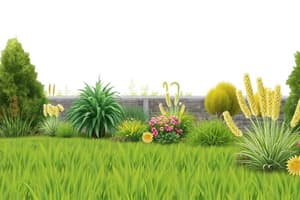Podcast
Questions and Answers
What is the main purpose of fertilization in horticulture?
What is the main purpose of fertilization in horticulture?
to supply the growing plants with nutrients to enhance their growth and productivity
Which elements are considered macronutrients for plants?
Which elements are considered macronutrients for plants?
- Feather, Fish, Soybean, Alfalfa
- Iron, Zinc, Manganese, Copper, Boron, Molybdenum
- Carbon, Hydrogen, Oxygen, Nitrogen, Phosphorus, Sulfur, Potassium, Calcium
- Carbon, Hydrogen, Oxygen, Nitrogen, Phosphorus, Potassium, Magnesium, Sulfur (correct)
The ideal starting range of Carbon to Nitrogen Ratio (C:N) for composting is ____:1.
The ideal starting range of Carbon to Nitrogen Ratio (C:N) for composting is ____:1.
25
Green manure crops are primarily grown to reduce soil fertility.
Green manure crops are primarily grown to reduce soil fertility.
Study Notes
Fertilization
- Fertilization is an essential agricultural practice to supply growing plants with nutrients, enhancing their growth and productivity.
- A fertilizer is a natural or synthetic substance containing one or more recognized plant nutrients, applied to the soil or the plant to adjust the growing plant's nutritional status.
Types of Fertilizers
- Organic fertilizer
- Chemical (synthetic) fertilizer
- Bio-fertilizer
Elements Needed for Plant Life
- Plants need at least 16 elements, including carbon, hydrogen, oxygen, nitrogen, phosphorus, sulfur, potassium, calcium, and magnesium.
- Plants obtain carbon from the atmosphere and hydrogen and oxygen from water; other nutrients are taken up from the soil.
- Fertilization provides plants with essential nutrients, divided into macronutrients and micronutrients (trace elements).
Macronutrients and Micronutrients
- Macronutrients: elements needed in large quantities, including [C, H, O2, N, P, K, Ca, Mg, and S).
- Micronutrients: elements needed in small quantities, including [Fe, Zn, Mn, Cu, B, and Mo].
Organic Fertilization
- Benefits of organic fertilization:
- Provides plants with their nutritional needs
- Enhances soil properties, increasing water holding capacity and aeration
- Effects of organic fertilization:
- On sandy soils: increases water holding capacity
- On clay soils: increases aeration and decreases compactness
Benefits of Humus
- Increases water holding capacity
- Is a slow-releasing source of nutrients
- Makes soil darker, increasing soil absorbance of sunlight and temperature
- Enhances aeration and soil drainage in compacted soils
Types of Organic Fertilization
- Manure: organic matter, mostly derived from animal feces, used as fertilizer in agriculture
- Classifications of manure:
- Animal manures (e.g., cattle, chicken)
- Guano fertilizer (excrement of seabirds or bats)
- Compost (product of controlled biological decomposition of organic materials)
- Green manure (crops grown and incorporated into the soil to improve soil quality)
Composting Process
- Inputs: organic materials (feedstocks) with carbon and nutrients
- Outputs: compost (humus), heat, and gases
- Key variables for controlling the composting process:
- Type of organic matter (feedstock)
- Carbon to Nitrogen Ratio (C:N)
- Pile moisture
- Pile aeration
- Pile size
- Temperature
- Time
Characteristics of Compost
- Dark, loose, and crumbly texture
- Earthy smell
- Rich in nutrients
- Ready to use in about three to five months
Studying That Suits You
Use AI to generate personalized quizzes and flashcards to suit your learning preferences.
Description
This quiz covers the principles of horticulture, focusing on post-planting horticultural practices, including fertilization. Learn about the importance of fertilizers in enhancing plant growth and productivity.




